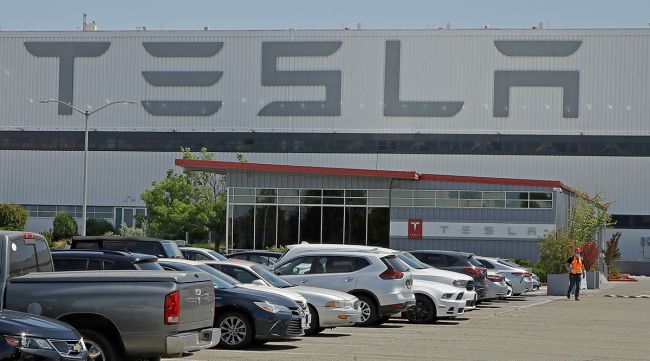A Tesla dealer in Fremont, Calif. (Ben Margot/Associated Press)
For the first time in California, one out of every four new cars sold in the last quarter were zero-emission vehicles, Gov. Gavin Newsom announced this week.
Policymakers have long prioritized EV sales as part of the state’s climate goals to reduce greenhouse gas emissions. To reach such goals, the state will require all new vehicles sold in California to be hybrid or electric by 2035.
In April — nearly two years ahead of schedule — California already surpassed its target of selling 1.5 million EVs to date.
“California is showing the world what’s possible — fostering innovation and creating space for an industry to flourish,” Newsom said in a release. “Thanks to our unparalleled incentives that make it cheaper than ever, we’re not leaving anyone behind.”
More than 25% of all new vehicles sold in the last quarter were EVs, according to the California Energy Commission, with sales for the three-month period totaling 125,939.
More than 1 in 4 new cars sold in California in Q2 were electric vehicles!
California is showing the world what’s possible – fostering innovation and creating space for an industry to flourish.
Get $$ for an EV: https://t.co/hrOtAjdpZF pic.twitter.com/wVumg7ETRv
— Office of the Governor of California (@CAgovernor) August 2, 2023
California has sold more than 1.6 million electric vehicles to date and accounts for 34% of all EV sales in the country, according to a market report by the nonprofit Veloz, which raises awareness about electric vehicles.
California leads the nation in promoting electric vehicle sales, having invested more than $5 billion to transition the state away from gas-powered vehicles.
In 2018, then-Gov. Jerry Brown set a goal to have 5 million zero-emission vehicles on California roads by 2030. Two years later, Newsom issued an executive order to ban the sale of gasoline-powered passenger cars by 2035.
Last year, the California Air Resources Board mandated that at least 35% of all 2026 passenger cars and trucks sold in the state be zero-emission vehicles. The rate will increase each year, reaching 68% in 2030 and 100% by 2035.
To promote the sale of green vehicles, the state offers rebates of up to $7,500 for battery-electric and hydrogen fuel cell vehicles and up to $6,500 for plug-in hybrids.

Host Michael Freeze clarifies the differences between predictive and preventive maintenance. He gives fresh commentary on everything from how enhanced connectivity boosts your preventive maintenance plans to what predictive possibilities AI can offer your shop. Tune in above or by going to RoadSigns.ttnews.com.
“Californians are shifting toward cleaner vehicles, putting a zero-emissions future within sight for [the] state’s transportation sector,” CARB Chair Liane Randolph said in an email.
“Through aggressive policies and programs that help low-income residents make the switch, the milestone makes it clear that California is leading the way toward cleaner air,” she said.






